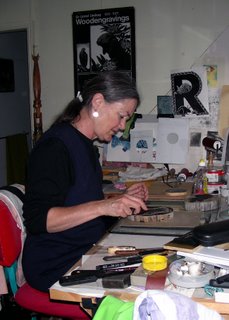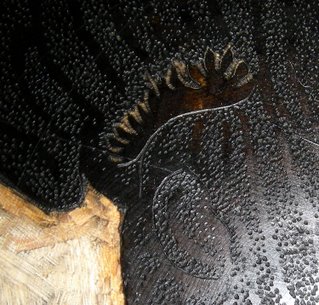 There's a latex cast of a fish on Rhyll's work table. Not to mention a goat moth, a fossilised freshwater mussel and a notebook fashioned from brown paper and a Monopoly board. (Monopoly boards make good covers, Rhyll told me. Now the ladies at the op shop keep them for her. The only problem is she's started a collection ...) And there are prints and paintings everywhere. Of course.
There's a latex cast of a fish on Rhyll's work table. Not to mention a goat moth, a fossilised freshwater mussel and a notebook fashioned from brown paper and a Monopoly board. (Monopoly boards make good covers, Rhyll told me. Now the ladies at the op shop keep them for her. The only problem is she's started a collection ...) And there are prints and paintings everywhere. Of course.Rhyll Plant is a biological illustrator and print maker. The biological illustrations—mostly zoological—are absolutely accurate. At the moment, she's producing a series of line portraits of brown snakes for a scientific publication. Those works for a specialised audience but the prints are for everyone.
 Squid Row is one of a series of prints with the theme of collective nouns. There's a scuttle of crabs, a frieze of penguins and a range of others that will make you groan at first and then wish you'd thought of them. (Puns are Rhyll's forte. She has also produced an exhibition of fish prints called Moray Patterns. A couple of years ago, she won the Swan Hill Print & Drawing award for Cod Pieces, a life-size depiction of a Murray cod printed from several blocks. The work will be on display at the Swan Hill Regional Art Gallery from December as part of an exhibition about the Murray cod.)
Squid Row is one of a series of prints with the theme of collective nouns. There's a scuttle of crabs, a frieze of penguins and a range of others that will make you groan at first and then wish you'd thought of them. (Puns are Rhyll's forte. She has also produced an exhibition of fish prints called Moray Patterns. A couple of years ago, she won the Swan Hill Print & Drawing award for Cod Pieces, a life-size depiction of a Murray cod printed from several blocks. The work will be on display at the Swan Hill Regional Art Gallery from December as part of an exhibition about the Murray cod.) The Squid Row cephalopod is Sepioloidea lineolata, a handsome little animal that looks as if it's wearing striped pyjamas. The block on which it is engraved is a round of Huon pine. Rhyll carved the image using a set of tools that she bought from a friend of a friend who wanted to get rid of his grandfather's belongings. He told her she could have whatever she liked. Although a lot caught her eye, Rhyll restricted herself to some books and the tools, which were orange with rust. She didn't know what they were but they had a good feel.
The Squid Row cephalopod is Sepioloidea lineolata, a handsome little animal that looks as if it's wearing striped pyjamas. The block on which it is engraved is a round of Huon pine. Rhyll carved the image using a set of tools that she bought from a friend of a friend who wanted to get rid of his grandfather's belongings. He told her she could have whatever she liked. Although a lot caught her eye, Rhyll restricted herself to some books and the tools, which were orange with rust. She didn't know what they were but they had a good feel.  When I ran my fingers over the surface of the block, I could barely detect the texture. That's part of the artist's secret business. The ink is applied in a very fine layer that has to be just right. There's little leeway. Too thin and it's patchy; too thick and it's like pasta sauce. Rhyll's Monopoly-bound notebook contains the recipes for inks used at different temperatures on different blocks of wood. What works on boxwood on a warm day won't work on Huon pine of a cool day.
When I ran my fingers over the surface of the block, I could barely detect the texture. That's part of the artist's secret business. The ink is applied in a very fine layer that has to be just right. There's little leeway. Too thin and it's patchy; too thick and it's like pasta sauce. Rhyll's Monopoly-bound notebook contains the recipes for inks used at different temperatures on different blocks of wood. What works on boxwood on a warm day won't work on Huon pine of a cool day. It's a combination of creative art and precise science. Few other artists have the skill to mix them successfully.
For another squid print see this earlier post, Wooden 'art.
(And thanks to Rhyll for the title.)